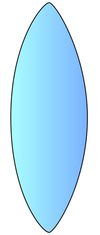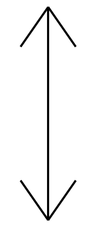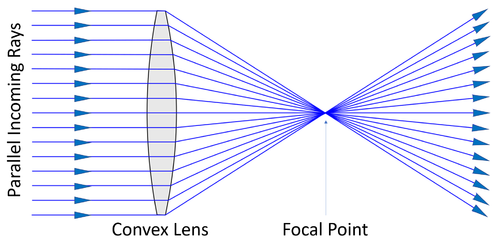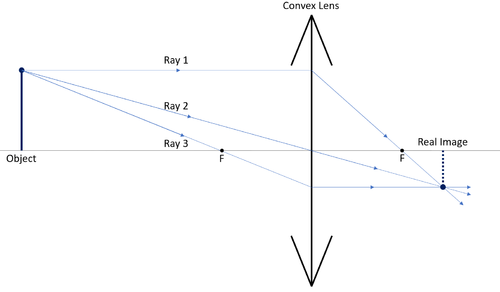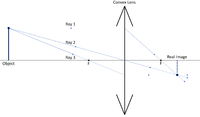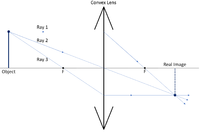Difference between revisions of "Convex Lens"
(→Key Stage 4 Higher) |
(→Key Stage 4 Higher) |
||
| Line 53: | Line 53: | ||
| style="height:20px; width:200px; text-align:center;" |A [[diagram]] showing how to find the [[Focal Length|focal length]] of a '''convex [[lens]]'''. | | style="height:20px; width:200px; text-align:center;" |A [[diagram]] showing how to find the [[Focal Length|focal length]] of a '''convex [[lens]]'''. | ||
|} | |} | ||
| − | + | To find the [[Focal Length]] of a '''convex [[lens]]''': | |
*[[Focus]] the [[image]] of a "distant object" onto a [[screen]]. | *[[Focus]] the [[image]] of a "distant object" onto a [[screen]]. | ||
*[[Measure]] the [[distance]] between the [[lens]] and the [[screen]]. | *[[Measure]] the [[distance]] between the [[lens]] and the [[screen]]. | ||
: The [[Image Distance|image distance]] (the distance between the [[focus]]sed [[image]] and the [[lens]]) is the same as the [[Focal Length|focal length]] for a "distant object". | : The [[Image Distance|image distance]] (the distance between the [[focus]]sed [[image]] and the [[lens]]) is the same as the [[Focal Length|focal length]] for a "distant object". | ||
: If the [[Object Distance|object distance]] (the distance between an [[object]] and a [[lens]]) is too small, then the [[Focal Length|focal length]] is not the same as the [[Image Distance|image distance]]. | : If the [[Object Distance|object distance]] (the distance between an [[object]] and a [[lens]]) is too small, then the [[Focal Length|focal length]] is not the same as the [[Image Distance|image distance]]. | ||
| + | |||
| + | ===Ray Diagrams=== | ||
| + | {| class="wikitable" | ||
| + | |- | ||
| + | |[[File:ConvexRayDiagram1.png|center|500px]] | ||
| + | |- | ||
| + | | style="height:20px; width:200px; text-align:center;" |A [[diagram]] showing the [[Ray Diagram|ray diagram]] for a '''convex [[lens]]'''. | ||
| + | |||
| + | In this [[diagram]]: | ||
| + | |||
| + | "Ray 1" is shown crossing the [[Focal Point|focal point]] of the [[lens]] after being [[refract]]ed. | ||
| + | |||
| + | "Ray 2" is shown passing through the centre of the [[lens]]. | ||
| + | |||
| + | "Ray 3" is shown crossing the [[Focal Point|focal point]] before the [[lens]]. | ||
| + | |||
| + | The [[diagram]] shows that a [[diminish]]ed [[Real Image|real image]] is produced when the [[Object Distance|object distance]] is greater than the [[Focal Length|focal length]] of the '''convex [[lens]]'''. | ||
| + | |} | ||
| + | |||
| + | {| class="wikitable" | ||
| + | |- | ||
| + | |[[File:ConvexRayDiagram1.png|center|200px]] | ||
| + | |[[File:ConvexRayDiagram2.png|center|200px]] | ||
| + | |- | ||
| + | | style="height:20px; width:200px; text-align:center;" colspan = "2" |Comparing these two [[diagram]]s shows that the [[image]] size increases as the [[Object Distance|object distance]] approaches the [[Focal Length|focal length]] of the [[lens]]. | ||
| + | |} | ||
| + | |||
| + | ===Magnification=== | ||
| + | For further details, see [[magnification]]. | ||
| + | |||
| + | The equation for the [[magnification]] of a '''convex [[lens]]''' is: | ||
| + | |||
| + | Magnification = (Image Length)/(Object Length) | ||
| + | |||
| + | <math>Magnification = \frac{L_i}{L_o}</math> | ||
| + | |||
| + | Where: | ||
| + | |||
| + | <math>{L_i}</math> = Length of the [[image]]. | ||
| + | |||
| + | <math>{L_o}</math> = Length of the [[object]]. | ||
Revision as of 12:02, 24 February 2019
Contents
Key Stage 3
Meaning
A convex lens is a shaped piece of glass that is thickest at the centre and thinnest at the edges.
| A picture of a convex lens. | They symbol used in diagrams to represent a convex lens |
About Convex Lenses
- A convex lens causes parallel rays of light to converge, so it can also be called a converging lens.
- A convex lens is used to focus light.
| A convex lens focuses parallel rays to a focal point. |
Key Stage 4 Higher
Meaning
A convex lens is a shaped piece of glass that is thickest at the centre and thinnest at the edges.
| A picture of a convex lens. | They symbol used in diagrams to represent a convex lens |
About Convex Lenses
- A convex lens causes parallel rays of light to converge, so it can also be called a converging lens.
- A convex lens is used to focus light.
Finding the Focal Length
| A convex lens focuses parallel rays to a focal point. |
- The focal length of a convex lens is the distance between the focal point and the centre of the lens.
| A diagram showing how to find the focal length of a convex lens. |
To find the Focal Length of a convex lens:
- Focus the image of a "distant object" onto a screen.
- Measure the distance between the lens and the screen.
- The image distance (the distance between the focussed image and the lens) is the same as the focal length for a "distant object".
- If the object distance (the distance between an object and a lens) is too small, then the focal length is not the same as the image distance.
Ray Diagrams
| A diagram showing the ray diagram for a convex lens.
In this diagram: "Ray 1" is shown crossing the focal point of the lens after being refracted. "Ray 2" is shown passing through the centre of the lens. "Ray 3" is shown crossing the focal point before the lens. The diagram shows that a diminished real image is produced when the object distance is greater than the focal length of the convex lens. |
| Comparing these two diagrams shows that the image size increases as the object distance approaches the focal length of the lens. | |
Magnification
For further details, see magnification.
The equation for the magnification of a convex lens is:
Magnification = (Image Length)/(Object Length)
\(Magnification = \frac{L_i}{L_o}\)
Where\[{L_i}\] = Length of the image.
\({L_o}\) = Length of the object.
